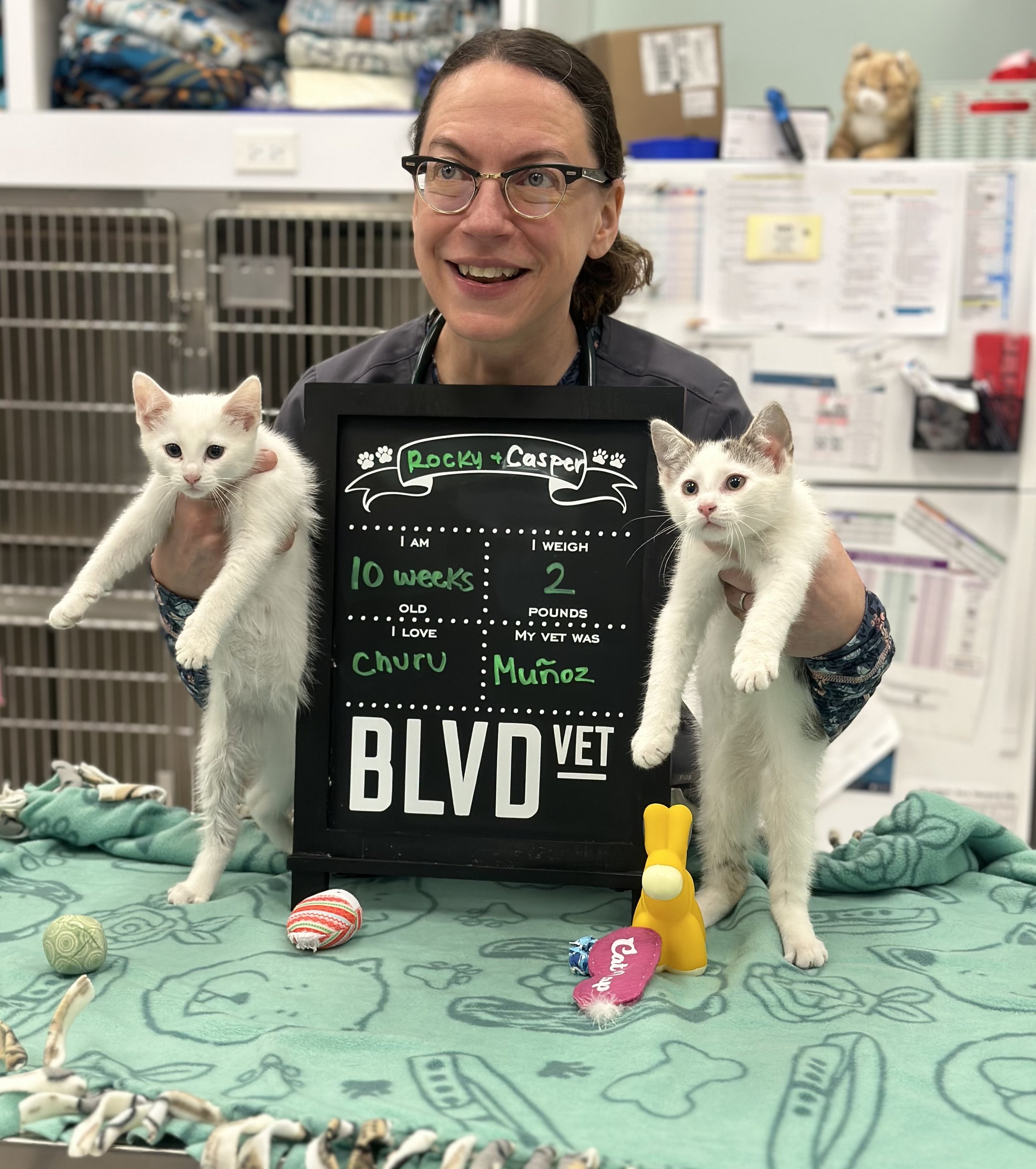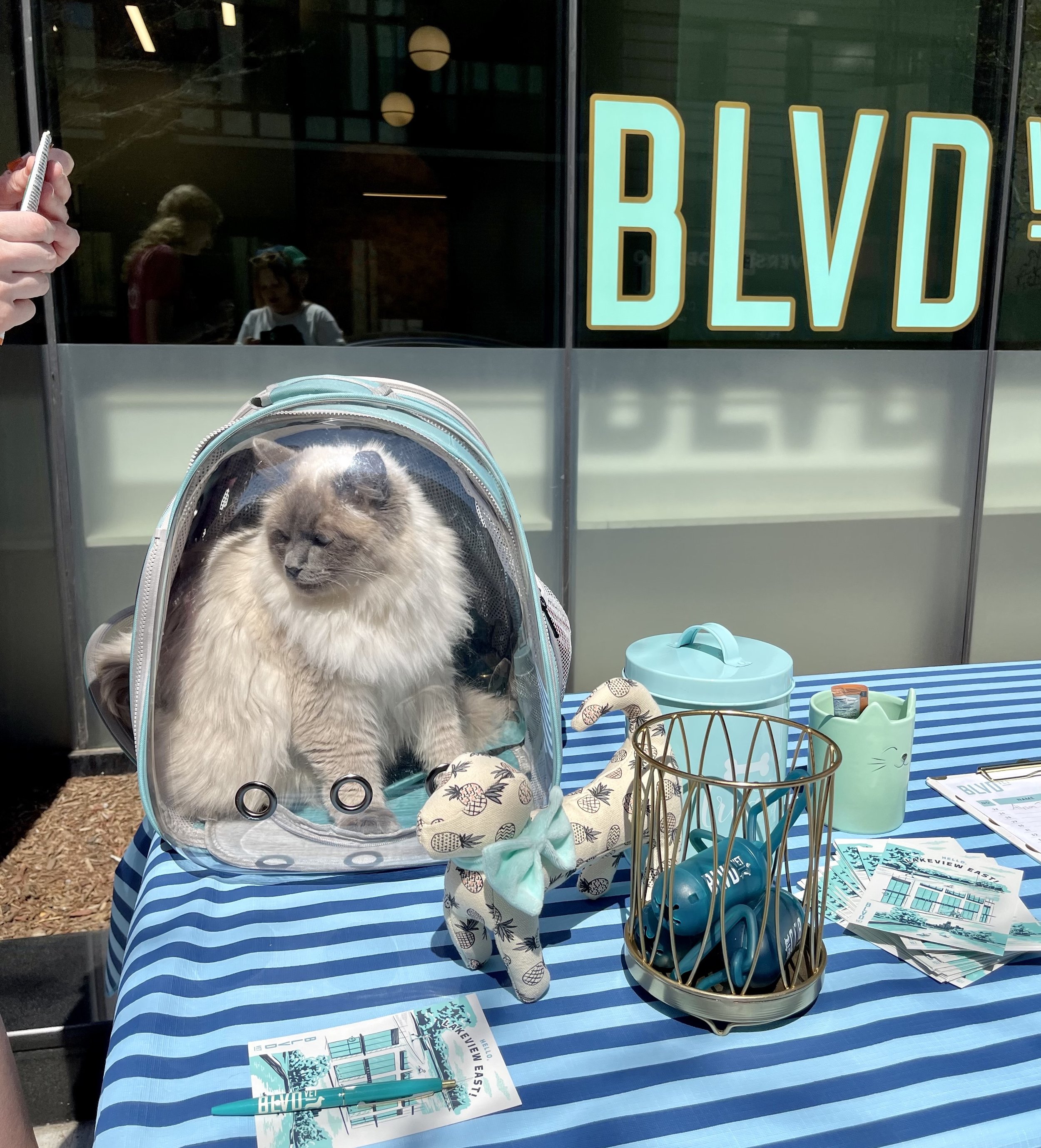Feeding My Cat 101
Like with dog food, the number of cat foods on the market can feel overwhelming! Picking the right food for your feline can feel like a daunting task, but it doesn’t have to be! We spoke with veterinary technician, Alyssa, to get the inside scoop on how to pick a food for your furry family member.
Feeding My Cat 101
by Alyssa H., Veterinary Technician and Continuing Education Coordinator
Peer Reviewed by Dr. Sapato, BLVD Vet Logan Square Medical Director
Why is choosing the right food so important?
While you may eat a diverse diet that changes each day, your cat eats the same food every day, year after year. It’s important to find a nutritious, balanced diet so that they don’t develop dangerously low or high levels of any single nutrient. Additionally, selecting the right food for your cat can significantly extend their lifespan and quality of life!
At BLVD Vet, our veterinarians follow science. Our recommendations can and will change as new research is published.
The top 4 aspects of diet our team recommends are protein from meat sources, a mix of wet and dry food, age appropriate diet and well trusted, research backed brands like Royal Canin, Hill’s and Purina.
Protein from Meat Sources. Cats are obligate carnivores, meaning that they must eat meat as a part of a healthy diet. A cat’s ability to create necessary proteins is different from our own, and they need certain preformed nutrients that are only available in animal meat to be able to maintain good health.
A mix of wet and dry food. There are a number of reasons why we prefer a mix of wet and dry food for our cats. Wet food has a high protein content, which is a necessary component of a balanced feline diet. It also is packed with moisture - at least 75% of a canned food is water! Canned food keeps our cats hydrated, especially since they don’t always like to drink from the water bowl as often as dogs do. Wet food is also known to play a special role in the health of male cats. Because of their anatomy, male cats are more prone to urinary obstruction, and are also known to be more prone to developing diabetes. Staying hydrated and at a healthy weight can reduce the risk of developing these conditions, which is easier when you feed wet food!
FACT or FICTION: Wet food is more calorie dense than dry food.
FICTION - Wet food is actually less dense than dry food, meaning your cat can eat a larger quantity of wet food and still end up with the same calorie intake as they would eating a smaller amount of dry kibble! Don’t worry, you don’t necessarily need to throw out your cat’s bag of kibble yet! Kibble can be a great way to give enrichment to your cat, and help prevent the buildup of dental disease. There are special diets, like Hill’s t/d, that are specifically formulated to prevent and reduce dental disease. Dry food is also easier to use with puzzle feeders and automatic food dispensers, and can be a great supplement for cats who like to munch on food overnight.
Age appropriate diet. This can be found by looking for a Nutritional Adequacy Statement located on the food packaging.
The Association of American Feed Control Officials (AAFCO) creates model guidelines that are then adopted by state and federal governments to regulate pet foods. They have several different life stages:
gestation/lactation: for pregnant and nursing cats
Growth: for growing kittens
Maintenance: for full grown adults
all life stages: the diet satisfies requirements for all three life stages
While it might seem like the better choice because it covers more stages, “all life stages” diets give your pet less precise and less tailored nutrition than sticking to a diet that is formulated for a single life stage.
Unless otherwise directed by your veterinarian, adult cats over the age of 1 are recommended to eat a diet that is formulated for maintenance and kittens under 1 year of age are recommended to eat a diet that is formulated for growth. Just like humans, a cat’s nutritional needs change as they age. By choosing the correct life stage, you ensure that your cat is eating for their current health needs.
What about senior diets?
Most states and companies follow the AAFCO model guidelines, so until an AAFCO life stage is established there is no standard for what a senior diet should include. This means that all senior diets fall under the maintenance category. Each company decides what their senior food will look like, which is why it’s important to attend yearly veterinary exams where your veterinarian can recommend specific diets to meet your pet’s individual needs.
Well trusted, research backed brands like Royal Canin, Hill’s and Purina. These three companies have been around for a long time and have built a strong reputation within the veterinary community for creating species appropriate, science backed foods. We know that when we are feeding these diets that we are feeding our pets nutritionally balanced diets that undergo routine quality control testing to ensure safety and consistency.
On the back of the bag, a pet food usually has one of these two nutritional adequacy statements - the diet is either formulated to meet AAFCO standards, or used feeding tests using AAFCO procedures to determine a food complete and balanced. The most important difference between feed tested and formulated diets is that a diet that is feed tested has undergone minimum safety studies to ensure that what you’re feeding is safe for your pet. Additionally, feed tested foods are required to recertify every 5 years, whereas formulated diets are not. This means that a formulated diet could be created once and never touched again, regardless of how long it has been on the market or if the company has changed ingredient suppliers (which both impact the nutritional makeup of ingredients). We prefer seeing a diet that has undergone feeding tests because we know that at minimum, steps are being taken every 5 years to ensure that the diet matches with what has been formulated.
When it comes to quality control, think about how when you pick up a package of chicken from the store and some pieces are bigger than others, or have a little extra fat when others do not. While these are normal variations in fresh food, they can cause detrimental changes to the final diet formulation- pet food companies bring in truckloads of each ingredient regularly! To ensure that each ingredient and protein has a similar nutritional makeup, reputable companies complete quality control on each ingredient batch coming into their facilities. They stick to the same producers that they know and trust, and they also test the final product in every single batch to make sure that it not only matches the nutritional profile for the product, but is also free of contaminants that could cause harm to your pet. We trust research backed brands because not only do they have the science to support their diets, but they also have a longstanding history of transparency when it comes to the quality control they complete on their products.
I picked out my diet, now how much do I feed my cat?
Each diet has a different caloric density - how many calories are in each cup of food - so it’s important to take a look at the bag of food when you switch flavors or formulas. Every bag (and can!) of food will have a feeding guide where you can see how much the company recommends you feed your pet each day. This may change slightly based on how active your cat is. For adult cats, a general estimate of calorie intake is 200 kcal/day. For a more specific daily calorie count recommendation, please ask your veterinarian at your cat’s next appointment.
How do I feed?
The last piece of the puzzle is how you give your cat their food. A lot of what we know about the feeding habits of felines comes from how cats interact in the wild. Cats are hunters by nature, and in the wild would eat multiple smaller meals as they hunt and catch their prey. Domesticated cats prefer similar habits - small meals spread out throughout the day.
Unless otherwise recommended, we recommend measuring out your cat’s food and splitting it into multiple small servings throughout the day. This can be accomplished using wet food, dry food, or a combination of both. You can do this using puzzle toys, setting out food at specific times or by using an auto feeder that can give your pet food overnight and when you’re not home.
We recommend feeding a set amount of food each day rather than free feeding, because bored cats are prone to unintentional weight gain from overeating. Hunting takes up a large amount of time and energy for wild cats- this can mean that domesticated cats can end up bored and restless because they are unable to practice their natural instincts. To simulate hunting and prevent boredom, you can use a variety of cat- specific puzzle toys and feeders, creating “work” for your cat to complete. Check out our at home enrichment article here for more creative feeding methods.
Hydration tip! Cats prefer drinking water from a fresh running water source that is not near their food bowl or litter box. This is because running water is less likely to be contaminated than standing water near their food source or near where they go to the bathroom. You can accomplish this at home using a cat water fountain, and placing it in a separate area from their litter box and food bowl.
As a rule of thumb, always discuss nutrition with your veterinarian. Every cat is different and has their own special feeding needs - just like us! Consulting with a professional will be the best way to work through the plethora of food brands and labels.
We hope you found these tips useful and that they help keep you and your pet happy and healthy. Please don’t hesitate to schedule an appointment if you have any questions.
Sincerely,
The BLVD Team






